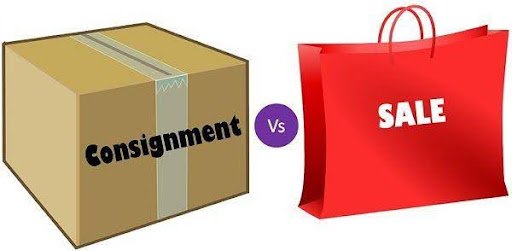In the world of supply chain management, there are many ways producers can choose to sell their items. While each method comes with its own benefits and risks, having a clear understanding of these differences can greatly impact the way you decide to run your business. As the landscape continues to evolve, staying well-informed about the best distribution practices is essential for sustainable growth and success. This article shines light on the key differences and benefits of consignment and direct sale.
What is a Consignment?
In consignment the owner of the goods or a consignor sends goods to a retailer or distributor (the consignee) without transferring ownership. The consignee sells the products on behalf of the consignor and only pays for the goods that are sold. The unsold items are typically returned to the consignor after a specified or determined period.
This commerce procedure is often beneficial in industries with unpredictable inventory turnover or for businesses dealing with unpredictable demand or excess stock. Business consign surplus inventory to minimize storage costs and avoid the risks of overstocking while still ensuring their products reach a broader audience.
Benefits of Consignment
- Consignment allows producers to reach a larger, targeted consumer base by placing their goods in multiple locations or with various retailers without the need to establish their own outlets. Consignees typically don’t pay upfront for the goods which reduces the immediate financial burden. Producers can boost their sales by leveraging the consignee’s established market presence and customer base, enabling larger-scale distribution and higher turnover.
- It is better commerce management for the retailers as they bear less financial risk compared to outright sales, especially in markets with uncertain demand. Retailors only pay for the products that are sold without worrying about the loss of unsold items. This is particularly beneficial in industries with fluctuating demand or seasonal trends, where it can be challenging to predict sales volumes.
What is Sale?
Sales can be associated with a contract that gives complete ownership of a product to an entity for an estimated price. Unlike consignment, the seller does not retain ownership once the transaction is complete. The buyer takes all risk and responsibility for the goods, whether they are used, sold, or disposed of.
Sale is a straightforward process, where in exchange for an agreed-upon price the complete ownership of the products is transferred from the seller to the buyer.
Benefits of sale
- For producers, sales provide an immediate cash flow with the transfer of ownership of goods in exchange for payment. Once the transaction is completed the buyer entails all the risk and responsibility for the goods. This allows a predicted cash flow and well-managed inventory.
- For retailers, sales reduce the complexity of inventory management and the need for ongoing coordination with producers. Retailers can also plan their stock and pricing strategies more efficiently, in line with the market demand.
Difference Between Consignment and Sale
Key Differences Between Consignment and Sale
| Aspect | Sale | Consignment |
| Ownership Transfer | Immediate | Upon sale |
| Payment Timing | Upfront | Post-sale |
| Risk Responsibility | Buyer | Consignor |
| Unsold Goods | Buyer’s Responsibility | Returned to Consignor |
| Relationship | Buyer-Seller | Principal-Agent |
| Control Over Pricing | Buyer usually decides | Consignor usually sets the price |
Let’s understand this in detail. In a sale ownership is completely transferred from the seller to the buyer immediately after completion of the transaction. Once the buyer pays the agreed-upon price, they assume full control of the goods. In contrast, in a consignment arrangement, ownership of the goods remains with the consignor until the goods are sold. The consignee holds the products in trust, meaning the consignor still retains ownership, which can be reclaimed if necessary.
In the process of a sale, the buyer pays for the goods at the time of purchase, which provides the seller with immediate cash flow. This is beneficial for producers or retailers who require quick payment for their goods to cover operating expenses or invest in new inventory. On the other hand, in consignment, retailers have the upper hand as they only pay for the goods that are sold, and any unsold goods are returned to the producer after a certain period. This arrangement frees retailers from upfront investment but can pose challenges for producers.
In a sale, once the transaction is complete the buyer takes all the responsibility and risks of the possessed goods. The transfer of ownership entails managing, utilizing, or reselling the products, and any associated risks, such as market demand fluctuations or product spoilage. But in consignment, the risks remain with the producer or the owner until the goods are sold. It means the consignor takes the financial hit, as the consignee does not purchase the goods upfront. This reduces risk for the consignee, who only assumes responsibility once the sale occurs.
For a sale, any unsold goods are no longer the responsibility of the seller once the transaction is finalized. If goods do not sell, the buyer assumes the risk and must manage or dispose of the unsold inventory. In consignment, the consignor retains ownership of unsold goods. If the consignee is unable to sell the products, they are typically returned to the consignor. This arrangement allows the consignor to retain control over their stock, with the option to redistribute or reclaim goods that do not sell.
Consignment requires a periodical account of sales by the consignee to the consignor. But in case of a sale there is no need of a periodical accounting of sales that a buyer provides to a seller.
Conclusion
To choose between consignment and sale depend on various factors. A business must understand its goals, cash flow needs, and inventory management strategy to apply any commerce procedure effectively. If you are looking to expand your market, then consignment is beneficial while sale is effective if you need immediate cash flow and want to avoid managing unsold stock. It is always advisable to assess your business needs, market dynamics, and financial considerations before deciding which method to adopt. By understanding the differences and benefits, businesses can make informed decisions that help drive growth and profitability.
Stay in touch to get more updates & alerts on VyvyManga! Thank you



